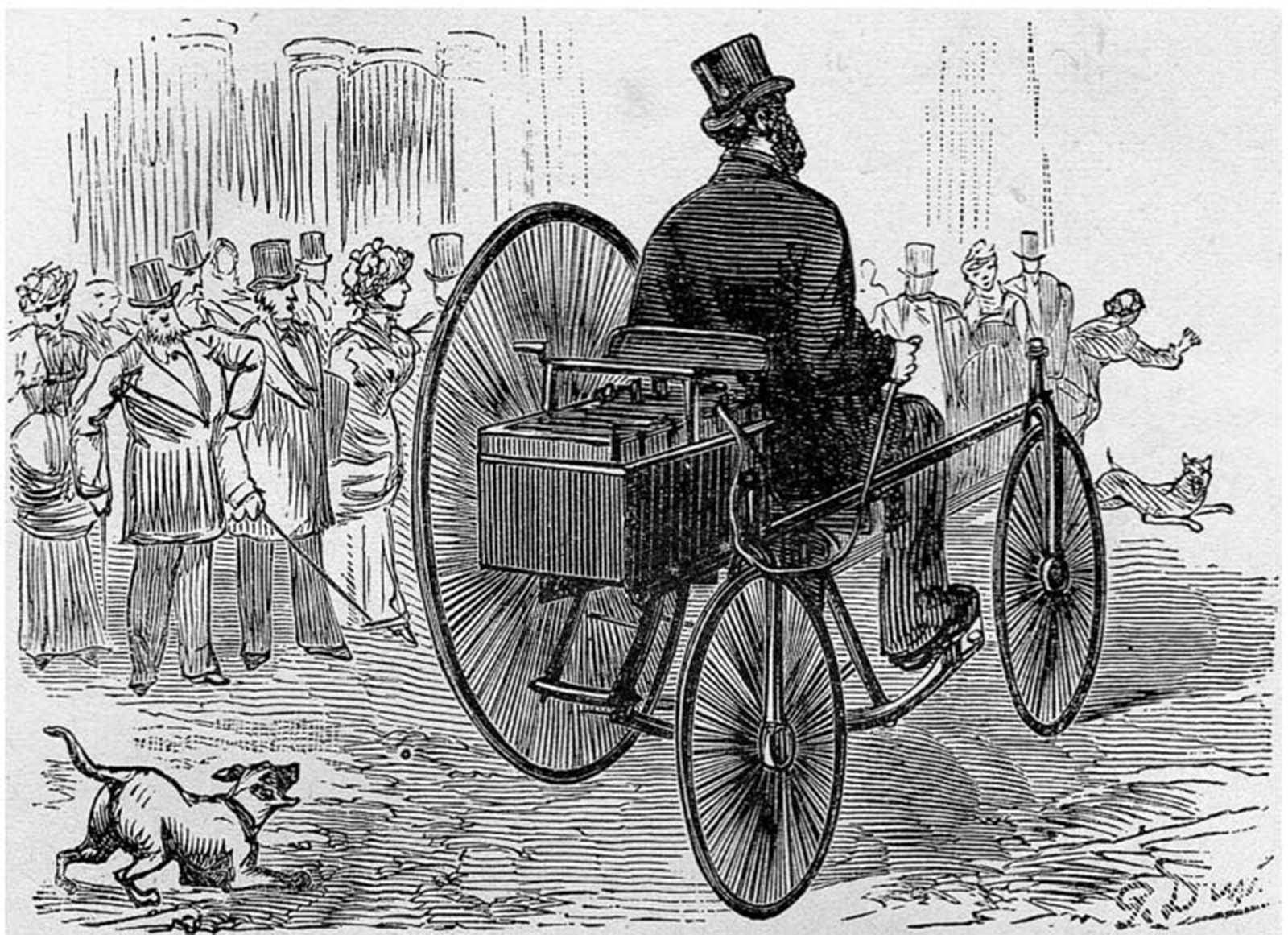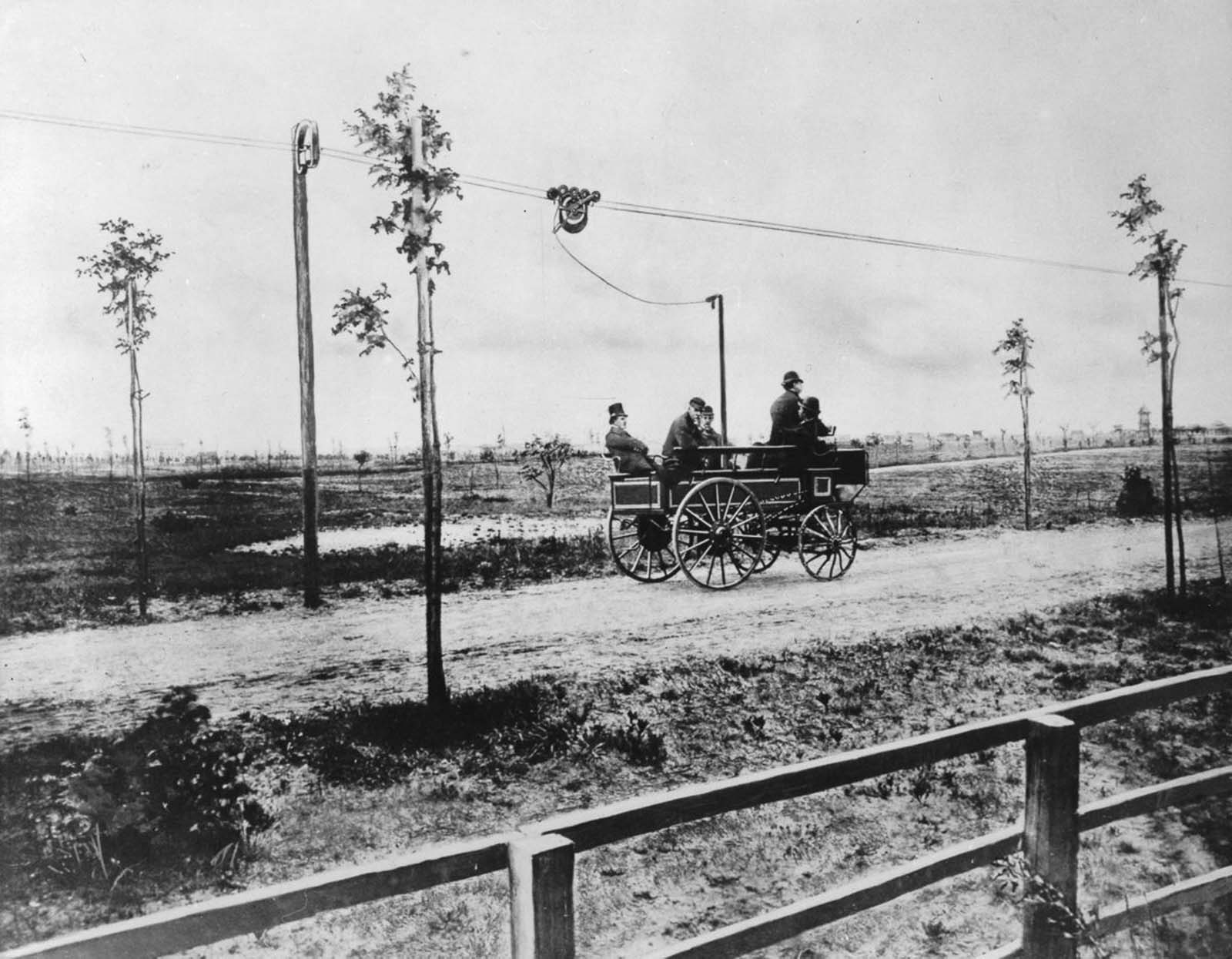
Thomas Edison poses with his first electric car, the Edison Baker, and one of its batteries. 1895.
Early electric cars found a lucrative market for driving around cities. Rechargeable batteries that provided a viable means for storing electricity on board a vehicle did not come into being until 1859, with the invention of the lead–acid battery by French physicist Gaston Planté.
What is likely the first human-carrying electric vehicle with its own power source was tested along a Paris street in April 1881 by French inventor Gustave Trouvé.
In 1880 Trouvé improved the efficiency of a small electric motor developed by Siemens (from a design purchased from Johann Kravogl in 1867) and using the recently developed rechargeable battery, fitted it to an English James Starley tricycle, so inventing the world’s first electric vehicle. Although this was successfully tested on 19 April 1881 along the Rue Valois in central Paris, he was unable to patent it.
English inventor Thomas Parker, who was responsible for innovations such as electrifying the London Underground, overhead tramways in Liverpool and Birmingham, and the smokeless fuel coalite, built the first production electric car in Wolverhampton in 1884, although the only documentation is a photograph from 1895.
France and the United Kingdom were the first nations to support the widespread development of electric vehicles. German engineer Andreas Flocken built the first real electric car in 1888.

Gustave Trouvé’s tricycle (1881), world’s first electric car.
Electric trains were also used to transport coal out of mines, as their motors did not use up precious oxygen. Before the pre-eminence of internal combustion engines, electric automobiles also held many speed and distance records.
Among the most notable of these records was the breaking of the 100 km/h (62 mph) speed barrier, by Camille Jenatzy on 29 April 1899 in his ‘rocket-shaped’ vehicle Jamais Contente, which reached a top speed of 105.88 km/h (65.79 mph).
Also notable was Ferdinand Porsche’s design and construction of an all-wheel drive electric car, powered by a motor in each hub, which also set several records in the hands of its owner E.W. Hart.
The first electric car in the United States was developed in 1890-91 by William Morrison of Des Moines, Iowa; the vehicle was a six-passenger wagon capable of reaching a speed of 23 kilometres per hour (14 mph).
It was not until 1895 that consumers began to devote attention to electric vehicles, after A.L. Ryker introduced the first electric tricycles to the U.S., by which point Europeans had been making use of electric tricycles, bicycles, and cars for almost 15 years.

Men ride on an electric car designed by Siemens and Halske outside of Berlin, Germany. 1882.
The Golden Age of Electric Cars
Interest in motor vehicles increased greatly in the late 1890s and early 1900s. Electric battery-powered taxis became available at the end of the 19th century.
In London, Walter Bersey designed a fleet of such cabs and introduced them to the streets of London in 1897. They were soon nicknamed “Hummingbirds” due to the idiosyncratic humming noise they made.
In the same year in New York City, Samuel’s Electric Carriage and Wagon Company began running 12 electric hansom cabs. The company ran until 1898 with up to 62 cabs operating until it was reformed by its financiers to form the Electric Vehicle Company.
Electric vehicles had a number of advantages over their early-1900s competitors. They did not have the vibration, smell, and noise associated with gasoline cars.
They also did not require gear changes. The cars were also preferred because they did not require a manual effort to start, as did gasoline cars which featured a hand crank to start the engine.
Electric cars found popularity among well-heeled customers who used them as city cars, where their limited range proved to be even less of a disadvantage.
Electric cars were often marketed as suitable vehicles for women drivers due to their ease of operation; in fact, early electric cars were stigmatized by the perception that they were “women’s cars”, leading some companies to affix radiators to the front to disguise the car’s propulsion system.

Thomas Edison and an electric car in 1913.
Acceptance of electric cars was initially hampered by a lack of power infrastructure, but by 1912, many homes were wired for electricity, enabling a surge in the popularity of cars.
In the United States by the turn of the century, 40 percent of automobiles were powered by steam, 38 percent by electricity, and 22 percent by gasoline.
A total of 33,842 electric cars were registered in the United States, and the U.S. became the country where electric cars had gained the most acceptance. Sales of electric cars peaked in the early 1910s.
In order to overcome the limited operating range of electric vehicles, and the lack of recharging infrastructure, an exchangeable battery service was first proposed as early as 1896.
The concept was first put into practice by Hartford Electric Light Company through the GeVeCo battery service and initially available for electric trucks.
The vehicle owner purchased the vehicle from General Vehicle Company (GVC, a subsidiary of the General Electric Company) without a battery and the electricity was purchased from Hartford Electric through an exchangeable battery.
The owner paid a variable per-mile charge and a monthly service fee to cover maintenance and storage of the truck. Both vehicles and batteries were modified to facilitate a fast battery exchange.
The service was provided between 1910 and 1924 and during that period covered more than 6 million miles. Beginning in 1917 a similar successful service was operated in Chicago for owners of Milburn Wagon Company cars who also could buy the vehicle without the batteries.

Columbia Electric’s (1896-99) “Victoria” electric cab on Pennsylvania Ave., Washington D.C., seen from Lafayette Park in 1905.

A Columbia electric car. 1899.

Roger Wallace drives his electric car. 1899.

Camille Jenatzy drives his self-designed electric car near Paris, France. He was first person to exceed 100 kilometers per hour (62 miles per hour) in a car. 1899.

Electric cars of the New York Edison Company line up in Manhattan. 1906.

An electric street sweeper cleans the roadway in Berlin, Germany. 1907.

German electric car, 1904, with the chauffeur on top.

Electric vehicles recharge at a power substation. 1909.

An advertisement for an electric car. 1910.

A Mercury Arc Rectifier Charging Set powers up an electric car in a garage in Cleveland, Ohio. 1910.

A woman uses a hand-cranked battery charger to charge her electric Columbia Mark 68 Victoria automobile. The Pope Manufacturing Company made the car in 1906 and the charger in 1912.

A Detroit Electric car drives on a mountain road between Seattle and Mount Rainier, Washington. 1920.
(Photo credit: Library of Congress / Schenectady Museum / Hall of Electrical History Foundation / CORBIS / Interim Archive / Getty Images).
Updated on: December 5, 2021
Any factual error or typo? Let us know.



